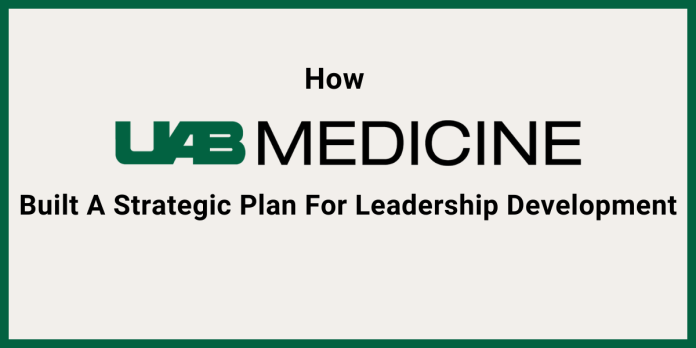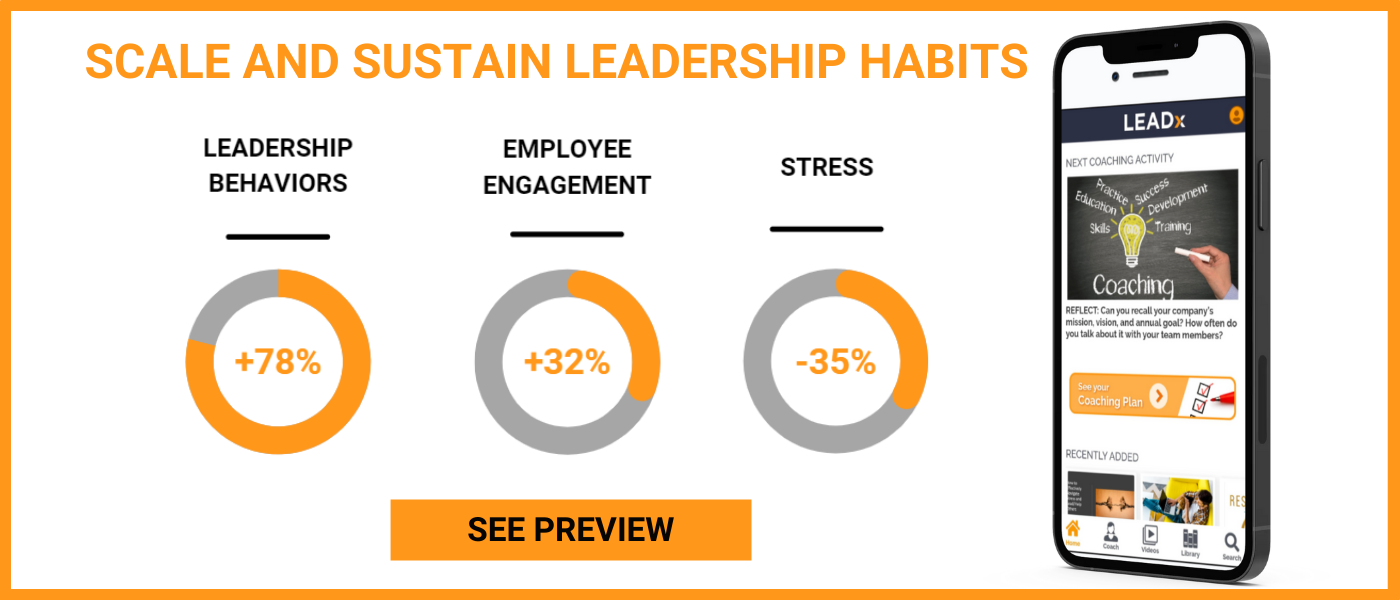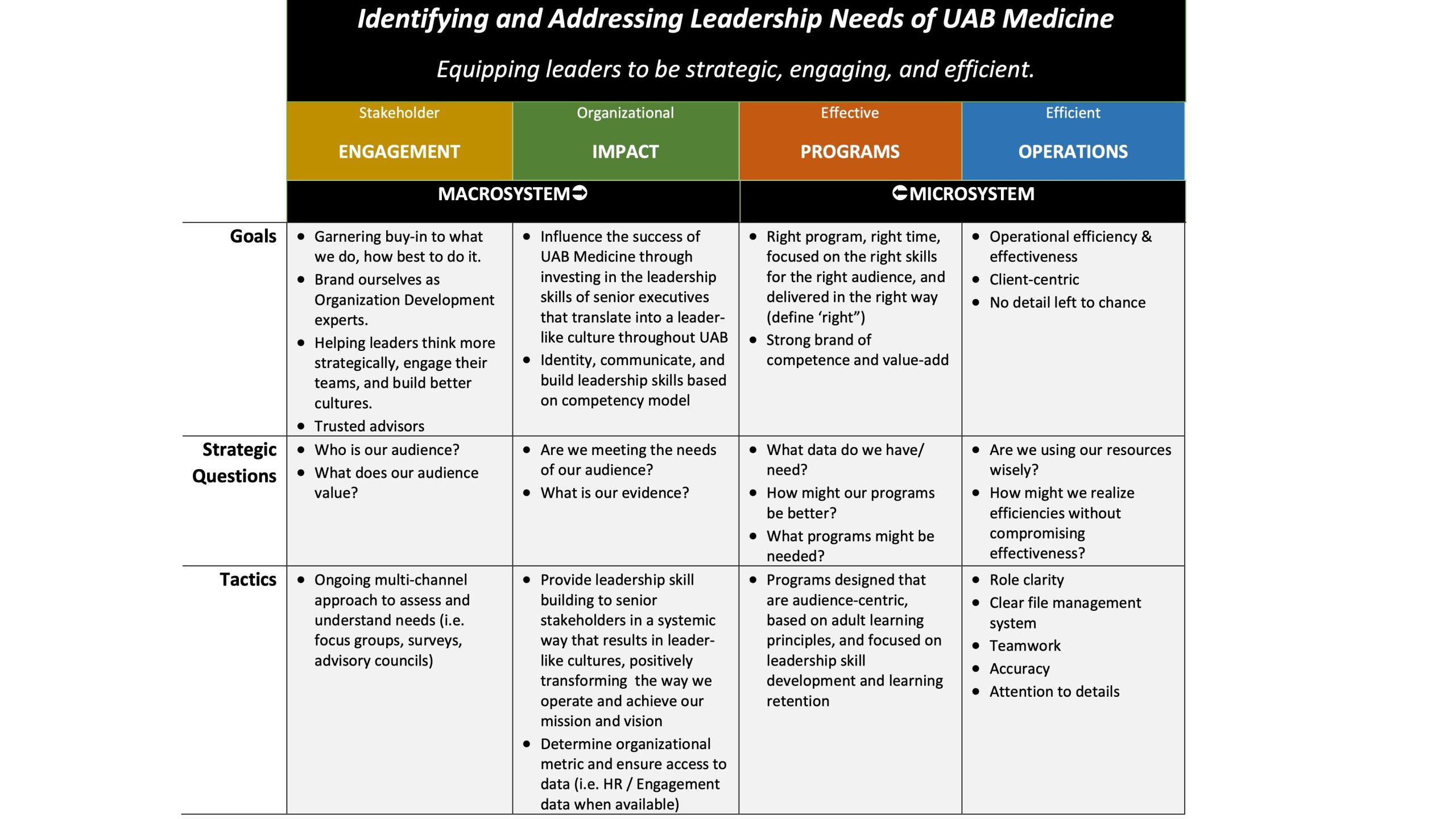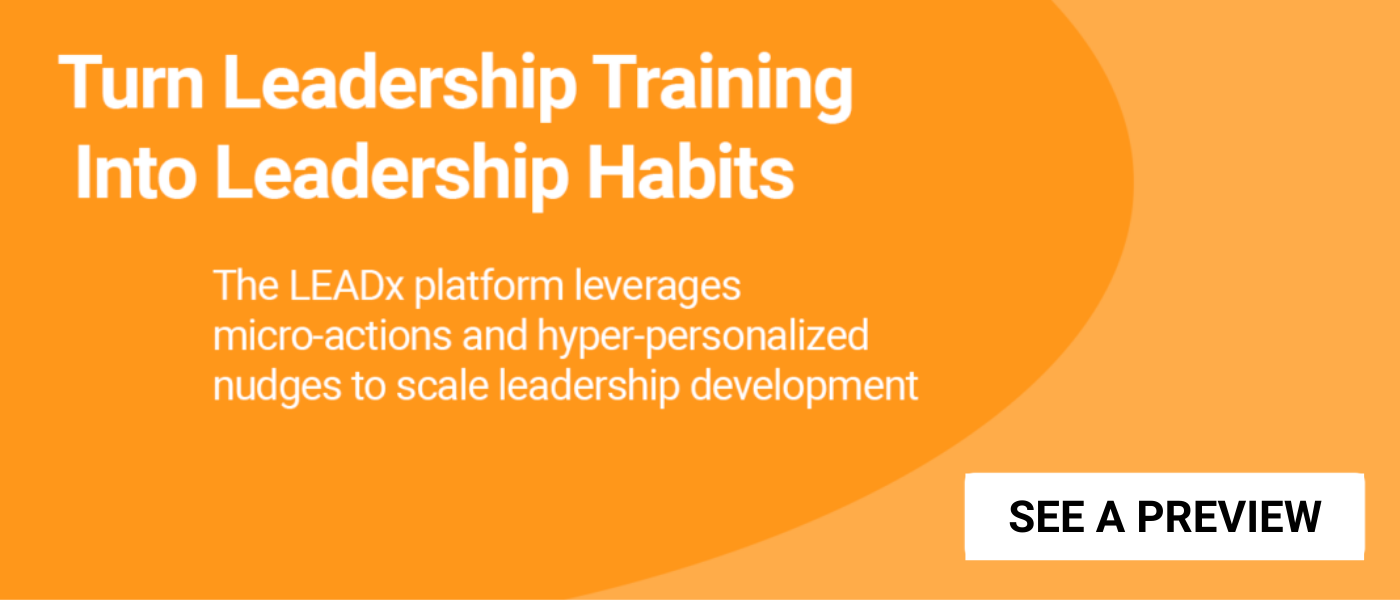
Over the course of hundreds of conversations and interviews with leadership development professionals, three pain points have come up repeatedly:
- “I don’t have buy-in from all of senior leadership.”
- “I don’t have enough budget.”
- “I don’t have a seat at the table.”
A razor-sharp strategic plan can help you combat each of these problems.
And even if you don’t have these problems, a strategic plan offers a lot. It can help you stay focused on what matters, communicate your strategy more clearly to your team and stakeholders, and achieve your goals.
 For this article, Matthew Painter Ph.D., the Director of Leadership Development at UAB Medicine (the University of Alabama at Birmingham), shared his process for putting together a strategic plan. He broke down his entire framework and shared insights on how to apply it.
For this article, Matthew Painter Ph.D., the Director of Leadership Development at UAB Medicine (the University of Alabama at Birmingham), shared his process for putting together a strategic plan. He broke down his entire framework and shared insights on how to apply it.
 How Painter Built His Model
How Painter Built His Model
Painter didn’t come into UAB Medicine with an existing framework. He researched, built, and refined his model over time:
“When I embarked on this process for UAB Medicine, I started with a straightforward framework where I asked myself about short-term and long-term improvement.
Short-term, I asked: How can we optimize what we're already doing? Are we doing things right?
Long-term, I asked: Are we positioned for sustainable impact? Are we doing the right things? It doesn't matter if we're doing them right if we're not doing the right things.”
 These questions then evolved into a more detailed model.
These questions then evolved into a more detailed model.
Painter constructed four key pillars:
- What is our stakeholder engagement?
- What is the organizational impact?
- Are our programs effective?
- Are our operations efficient?
This became the impetus for his model, where he added questions, goals, and tactics:
 To fill in this model, Painter follows a five-step process.
To fill in this model, Painter follows a five-step process.
- Clarify Your Mission, Vision, and Values.
Painter kicks off his model with mission, vision, and values.
He said, “The process begins with clarifying mission, vision, and values. It sounds obvious, but I think we often overlook this step. These components are our compass. At UAB, we had a conversation about our team’s values and how important it is to revisit them. We also encourage our internal stakeholders to do the same.”
From that strong foundation, Painter then begins to gather data.
- Collect Data: Go Deep and Wide
Data collection fuels your plan to add sustainable value.
Painter outlined six ways his team collects data at UAB Medicine.
- Brainstorm: Brainstorm with your team using Peter Drucker’s five questions. 1) What is your mission? 2) Who are your customers? 3) What does your customer value? 4) What results are you trying to accomplish? 5) What is your plan?
- Pre-Briefs: Ask, “What would make this event meaningful and effective? And what’s the best way to add sustainable value?”
- Debriefs or After-Action Reviews (AARs): “AARs have been an extremely rich source of improvement for us. We made a commitment: For every substantive event we deploy, we do an AAR. We've identified many things we need to improve in terms of our operations and value-add.”
- Stakeholder input: “There are all kinds of stakeholder inputs that we need to look at. Are there existing data sets? What existing data sets are available such as employee engagement or pulse surveys? What focus groups might we need to conduct? At UAB, we have a stakeholder advisory board comprised of a cross-section of key stakeholders that we use as a standing focus group.”
- Literature Reviews: “We look at all the relevant literature around our target problems.” We continue to look at external data and best practices and adopt and adapt from the literature where it makes sense. Essentially, we’re conducting Action Research.
- The Success Factors Approach: “If you did nothing else, do this: Ask yourself or your stakeholders, ‘What are the success factors associated with our service?’ This provides you with a lot of fuel for improvement.
The idea here is to cast a wide net in terms of who you approach and how you approach them.
- Make Sense of the Data and Generate Tactics
Data collection is not enough to jump-start your strategic plan.
How do you make sense of this data? What tactics could you deploy to address problems and opportunities uncovered during the data collection phase? How might you meet these needs?
Painter is a fan of crowdsourcing and thought partnering. The best ideas often come from the stakeholders themselves.
- Consider Your Short- and Long-Term Priorities
Now that you’ve cast your wide net, you can start to sort through what you’ve collected to focus on how you want to take action.
“You have all these ideas for action, so then you have to figure out what to do with all this data? How do you prioritize it? You have those short-term and long-term lenses that are critical. You don't want to do things just because they’re easy. This is about getting clear about how you prioritize. This helps you separate some of the emotions out of your priorities. This is also about defining your resource needs.”
Think of this as your Pareto principal. What 20% of your team’s work will lead to 80% of your results?
- Create A Clear, Palatable, and Socialized Plan
Painter outlined three essential components to keep top of mind as you write your plan:
- Clarity: Strategic goals and roles should be as straightforward as possible. What goal do we want to achieve, and is it clear to everyone what their part is in making it happen?
- Palatable: Make your plan approachable and easy to digest. Assume it will be passed around.
- Socialization: Make sure everyone is on the same page. Run your plan past your stakeholders and ask them for feedback and additional input. This is about getting input, but it’s also about inviting your stakeholders into the process and getting aligned.
From this point forward, your plan becomes your hub for day-to-day and long-term actions.
- Communicate Regularly to Establish Accountability and Refine Your Plan
Without communication, your plan is just an abstract document. Communicate regularly to maintain commitment and visibility.
- Accountability: Communicating your plan ensures tracked goals don’t get lost. It anchors goals to your day-to-day and breaks down long-term goals into assigned tasks at the individual level. Regular feedback loops are necessary to ensure execution.
- Feedback: As you communicate your plan to your stakeholders and team, you create a feedback system. Your stakeholders and teammates will help you identify when your actions deviate. The result is a steady stream of feedback.
- Growth: Your plan should change and improve as you execute it. As stakeholders and teammates communicate their experiences and on-the-job learnings, you can tweak, adjust, and reshape your plan.
Your Strategic Plan Is Your Engine For Growth
Follow this process to build and refine a robust and sustainable growth engine.






